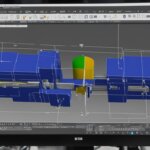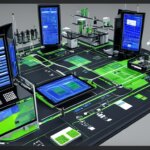Table of Contents
Computer-Aided Design or CAD software is a powerful tool used by designers and engineers to create, modify, analyse and optimize design models. It is a technology that has revolutionized the manufacturing industry by simplifying the design and production process. This article will explore the definition of CAD software and its various uses in design and engineering.
Key Takeaways
- CAD software enables designers and engineers to create, modify, analyse, and optimize design models.
- CAD software simplifies the design and production process, leading to improved efficiency and accuracy.
- CAD software is widely used in various industries, including automotive, aerospace, architecture, and product design.
- CAD software helps streamline workflows and increase productivity by facilitating collaboration among team members.
- Understanding CAD software and its capabilities can help individuals and businesses to achieve greater efficiency and innovation in their projects.
Understanding CAD Software
Computer-aided design (CAD) software is a powerful tool for creating accurate, detailed technical drawings and 3D models. By using CAD software, professionals in a wide range of industries can design and visualize their ideas quickly and efficiently, improving workflows and streamlining production processes. To fully understand CAD software, it’s important to consider its key features and functionalities, as well as the benefits it offers.
Key features and functionalities:
- The ability to create precise, to-scale designs and models with ease
- Intuitive user interfaces that requires minimal learning curve
- A wide range of tools for modelling, editing and rendering
- The ability to collaborate with team members across locations and timezones.
Benefits of using CAD software:
- Improved accuracy and reduced errors in the design process
- Time savings in the design phase, allowing for more revisions and iterations without significant cost increases
- Enhanced visualization of designs, allowing designers to better communicate their ideas to clients and stakeholders
- The ability to quickly and efficiently produce detailed documentation for manufacturers, reducing the time from design to production.
By having a clear understanding of the capabilities of CAD software, design and engineering professionals can greatly improve their productivity, accuracy, and creativity, all while reducing costs and mistakes.
Example Table: Key Features of Popular CAD Software
| Software | Key Features |
|---|---|
| AutoCAD | 2D and 3D Design, Modelling, Rendering and Animation, Collaboration, Cloud Storage |
| SolidWorks | Product Design, Simulation, Visualization, Technical Communication, Collaboration, Workflow Automation |
| CATIA | Product Design, Engineering, System Architecture, Modelling, Simulation, Collaboration, Cloud Storage |
| SketchUp | 3D Modelling, Visualization, Animation, Collaboration, 3D Printing Support |
Applications of CAD Software in Design and Engineering
As a powerful tool in the world of design and engineering, CAD software has a wide range of applications. One of its primary uses is in the creation of 2D and 3D models. With CAD software, designers and engineers can produce detailed and accurate representations of their ideas, allowing them to better visualise and communicate their concepts to others.
CAD software also streamlines the design process by automating repetitive tasks and calculations, freeing up time for more creative work. In addition, CAD software improves accuracy by eliminating errors that could occur in manual drawings. This leads to more reliable and precise designs and reduces the risk of costly mistakes during manufacturing or construction.
Collaboration is another benefit of CAD software. By using a common platform, team members can work together more efficiently and effectively, sharing information, making updates in real-time, and reducing the time required for revisions. Ultimately, this helps teams complete projects more quickly and with greater success.
Moreover, CAD software has a wide range of application areas across different industries. For example, architects use CAD software to produce floor plans and model buildings with great accuracy. Engineers use it to design complex structures and systems. Industrial designers use it to create 3D models of products. The medical industry uses CAD software to design and develop medical devices, prosthetics and implants. CAD software is also used in the fashion industry to create clothing and textile designs with exact precision.
As CAD software continues to evolve and improve, we can expect to see even more innovative applications and benefits in the future.
CAD Software Applications in Design and Engineering – A Comparison Table
| Application Area | CAD Software | Benefits |
|---|---|---|
| Architecture | AutoCAD, ArchiCAD | Accurate floor plans, detailed building designs |
| Engineering | SolidWorks, CATIA | Design of complex structures and systems, high precision |
| Industrial Design | Rhino 3D, Autodesk Alias | Creation of 3D models of products |
| Medical Device Manufacturing | Creo, Siemens NX | Design and development of medical devices, prosthetics and implants |
| Fashion Design | Kaledo, CLO 3D | Creation of clothing and textile designs with great precision |
In conclusion, CAD software has a wide range of applications in design and engineering, from creating 2D and 3D models to streamlining the design process, improving accuracy, and facilitating collaboration among teams. By leveraging CAD software, professionals in various industries can boost their productivity and efficiency, creating higher quality designs and products.
Conclusion
In conclusion, CAD software has become an essential tool for professionals in the fields of design and engineering. Its diverse applications, ranging from creating 2D and 3D models to streamlining workflows and facilitating collaboration, have made it a valuable asset to businesses and individuals alike. With the ability to improve accuracy, increase productivity, and promote innovation, CAD software is a must-have for anyone seeking to stay competitive in today’s fast-paced environment.
FAQ
What is CAD software?
CAD software, which stands for Computer-Aided Design software, is a type of computer software that allows professionals in design and engineering fields to create, modify, and analyze digital models of physical objects. It enables users to produce accurate and detailed 2D and 3D designs, helping them visualize and communicate their ideas effectively.
How does CAD software work?
CAD software uses various algorithms and mathematical equations to create and manipulate digital designs. It provides tools and functionalities that allow users to draw, edit, and modify shapes, dimensions, and materials. CAD software operates through a user-friendly interface, where designers can input measurements, specify parameters, and apply various engineering principles to optimize their designs.
What are the key features and functionalities of CAD software?
CAD software offers a wide range of features and functionalities to support the design process. Some key features include the ability to create 2D and 3D models, generate accurate measurements, apply realistic materials and textures, simulate movements and interactions, analyze structural integrity, and produce detailed documentation and technical drawings. Additionally, CAD software often integrates with other tools and technologies to enhance collaboration and project management.
What are the benefits of using CAD software?
There are several advantages to using CAD software. Firstly, it enables designers to create detailed and precise designs, reducing the chance of errors and rework. CAD software also offers the flexibility to easily make revisions and modifications to designs without starting from scratch. It accelerates the design process, allowing for faster iterations and increased productivity. Furthermore, CAD software facilitates collaboration among design teams, as multiple individuals can work on the same project simultaneously, share files, and provide feedback in real-time.
How is CAD software used in design and engineering?
CAD software is widely used in design and engineering industries for a variety of applications. It is utilized in architectural design to create floor plans, building structures, and 3D visualizations. In mechanical engineering, CAD software helps design and analyze complex systems, machinery, and components. It is also employed in industrial design, product development, civil engineering, and many other fields where precise and detailed design work is required.













